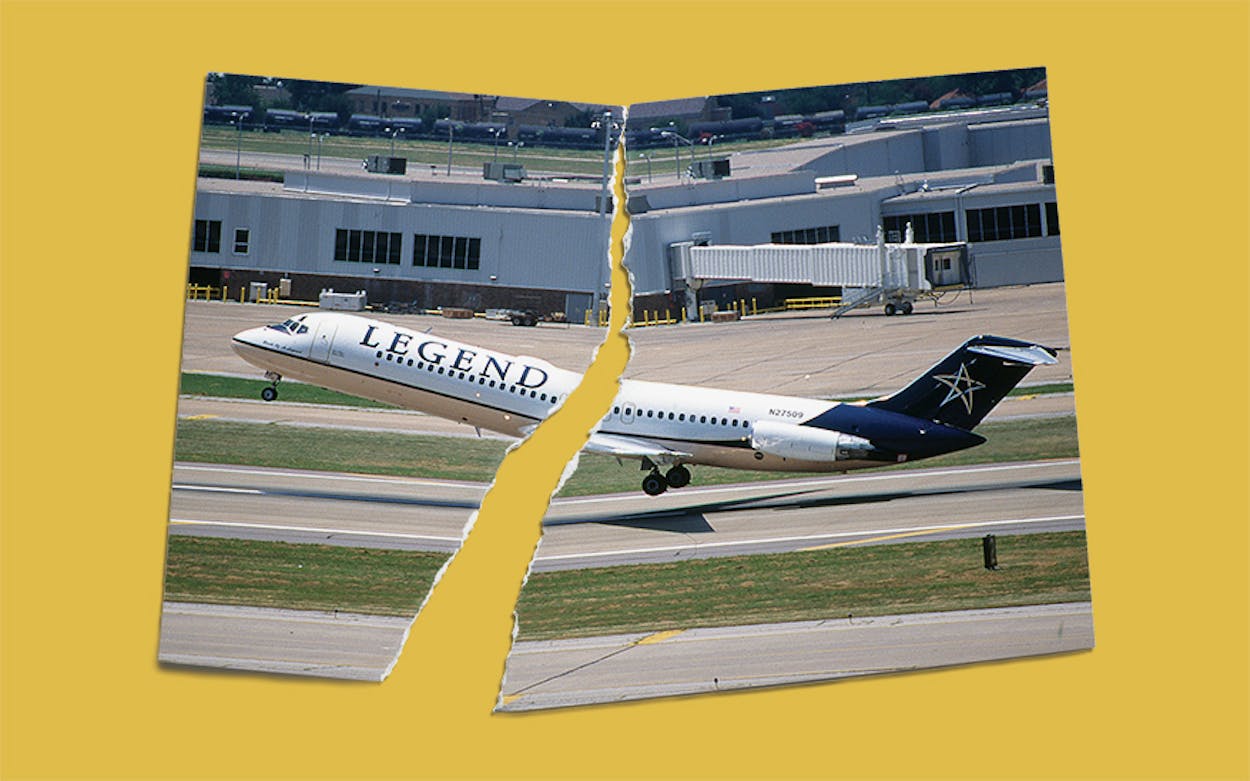Allan McArtor won’t ever forget the day Legend Airlines ran out of gas—literally. He was CEO of the Dallas-based carrier when it went broke in December 2000, after having waged a $20 million legal battle against American Airlines and the City of Fort Worth to secure the right to get off the ground in the first place.
“We had a fuel-purchase contract that we needed to pay,” McArtor, now 81 years old, told me recently from his Virginia home. “Our supplier was fully expecting me to say, ‘Look, we’re going to make it. We’ll get you paid.’ But I wasn’t going to lie to them. So we had to shut things down.”
Legend may have lost its business war, but its legacy lives on. Had the airline never existed, the Wright Amendment—the 1979 federal law that limited flights from Dallas Love Field to destinations within Texas and four contiguous states, which was fully repealed in 2014—might have taken much longer to undo. Legend’s fight to fly echoes both the early days of Southwest Airlines and the current complaints lodged by American and Southwest about the business model of Love Field–based JSX.
Like Southwest, Legend’s launch depended on a loophole in federal regulations. By originally limiting itself to flying within Texas, Southwest avoided the onerous oversight of the federal Civil Aeronautics Board, which controlled everything from flight routes to ticket prices for most U.S. airlines before commercial aviation was deregulated. The then-dominant Texas carrier Braniff, which was also based at Love Field, sued to keep Southwest from getting into the air, resulting in a four-year legal and regulatory fight. Southwest eventually prevailed, and its first flight rumbled down the runway in June 1971.
A quarter century later, in 1996, Legend’s primary investor, Dallas developer Bruce Leadbetter, also spotted a loophole and drew legal fire from a much larger competitor. He determined that jets with no more than 56 seats could fly beyond the Wright Amendment borders. But as soon as Leadbetter asked the U.S. Department of Transportation to okay Legend’s plan to reconfigure DC-9 jets, which typically carried about 100 passengers, to carry only 56 passengers, the feds told the nascent company its planes had to be built from scratch for the purpose.
Similarly, JSX’s operations are made possible by a regulatory carve-out that allows an airline flying thirty-seat jets to avoid crowded public airport terminals and the security hassles of Transportation Security Administration checkpoints. American, Southwest, and multiple pilots unions have aligned against that setup, and the Federal Aviation Administration is mulling a change to the current regulations, which could put JSX out of business.
Maybe JSX should seek the help of McArtor, who headed the FAA for two years under President Ronald Reagan. After McArtor joined Legend in 1997, he took the airline’s case to Capitol Hill. There he found that Alabama senator Richard Shelby was willing to listen.
Shelby was soon making a case that the Wright Amendment was bad for fliers because it drove up prices to and from Dallas, where American dominated the skies. By October 1997, he’d lined up enough support to give Legend what it wanted and more. The airline was newly permitted to fly reconfigured 56-seaters anywhere in the country from Love Field, and Wright Amendment restrictions were also lifted for larger jets flying to Alabama, Kansas, and Mississippi.
With that, the Wright Amendment began to unravel. And all of American’s later attempts to keep it in place—including a long public fight with Southwest in 2005 and 2006—couldn’t prevent its eventual repeal. Unfortunately that didn’t help Legend much. “All hell broke loose” when Shelby’s legislation passed, McArtor says. “We got sued by Fort Worth and American Airlines.”
A federal circuit court in New Orleans ruled in Legend’s favor, and the U.S. Supreme Court declined to hear American’s appeal (which is much the same legal path that earned Southwest the right to fly at the end of 1970). Still, by the time Legend got off the ground in April 2000, American had bought Braniff’s old gates at Love Field and was flying its own 56-seat jets to every destination on Legend’s route map. Legend had hoped to use those gates itself, so the startup airline was forced to counter American by building its own terminal, complete with a parking garage, adjacent to Braniff’s former headquarters building at Love Field. “American pulled out every stop,” McArtor says. “But we were still amazingly successful. That’s why we had to be eliminated.”
Legend didn’t have to take on new debt to pay for the terminal, which was owned by outside investors, and McArtor says Legend’s flights were full once it began operations. Still, it remained financially strapped because of the years of litigation. And that made it a challenge to stay in competition with American. Near the end of Legend’s life, McArtor spent a Saturday afternoon at the home of American’s then CEO, Don Carty, who had taken over from the legendarily aggressive Bob Crandall, in 1998. McArtor offered several compromises, including selling Legend to American. Carty passed, and the cordial meeting ended when Carty declared, without elaboration, “Legend’s business plan is incompatible with American Airlines.”
Just a couple weeks after that meeting, eight months after it had started flying, Legend folded. McArtor, who went on to lead the U.S. arm of aerospace giant Airbus, says he’s disappointed “in the corporate behaviors American engaged in,” but he’s not bitter. He does have a word of advice for JSX or any other airline that plans to go head-to-head with the behemoth from Fort Worth: “If you’re going to take on American Airlines at Love Field, you better tie your sneakers on real tight.”







